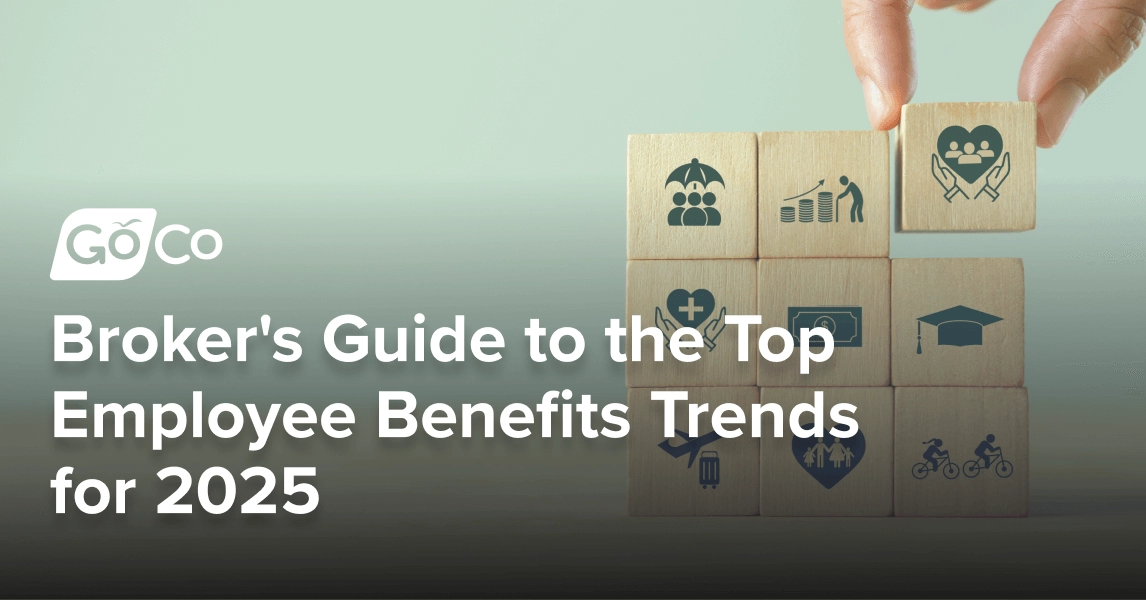Broker's Guide to the Top Employee Benefits Trends for 2025
A guide to the trends benefits brokers should watch for in 2025 and how to incorporate them into your offerings.
by Stephanie Kucharski - September 6th, 2024
As the workforce evolves, shifting employee expectations and economic conditions are reshaping the benefits landscape. To attract, retain, and engage top talent in 2025, companies must regularly reassess their benefits offerings to ensure they remain competitive and aligned with what current and potential employees truly value.
For benefits brokers, staying ahead of benefits trends is crucial. By understanding and leveraging emerging trends, you can provide your clients with the most relevant and appealing packages.
In this article, we will explore some of the employee benefits offerings that are gaining traction and actionable strategies to offer these benefits to your clients, demonstrating their value and securing your role as a trusted advisor.
1. Personalized Benefits
One-size-fits-all benefits packages are becoming a thing of the past. Employees now expect benefits that cater to their unique needs and circumstances. A MetLife benefits trends study found that 79% of employees want benefits tailored to their life stages, positions, and personal circumstances.
With personalized benefits plans, where employees can choose from a variety of options to create a package that suits them best, employers can better address the diverse needs of their workforce.
2. Mental Wellness Benefits
Millions of U.S. adults suffer from some form of mental illness every year, yet only 47% receive treatment. With 1 out of 5 U.S. workers considering leaving their company due to their mental health’s impact on their ability to work last year, the need for mental health support has become a necessity in the workplace to combat high turnover and low productivity.
Employers are recognizing the need to offer comprehensive mental wellness support, including access to counseling services, stress management programs, Employee Assistance Programs, and mental health day policies.
3. Financial Wellness Benefits
With costs continuing to rise, finances continue to be a significant concern for many employees, impacting their well-being. Financial stress can impact various aspects of an employee's life, including their productivity at work.
Financial wellness programs address this issue by providing employees with resources to manage their finances effectively. These programs may include financial planning services, debt management counseling, retirement planning workshops, and budgeting tools.
4. Inclusive Benefits
With the workforce becoming increasingly diverse, DEI initiatives are becoming integral to company culture. Employees are seeking environments where they feel valued, supported and their needs are met. One way companies are doing this is by offering an inclusive employee benefits package.
Offering benefits that meet a wide range of needs, such as gender-neutral parental leave, LGBTQ+ support services, and mental health resources tailored to different cultural backgrounds, can help companies attract and retain the right talent.
5. Sustainable and Ethical Benefits
Sustainability and corporate social responsibility (CSR) are becoming key factors in employee satisfaction and attraction. Employees are increasingly looking for employers who align with their values.
Benefits that match employee values, including eco-friendly options, sustainability-focused retirement plans, and volunteer programs that support environmental and social causes, can appeal to social conscious employees and enhance the company’s brand image.
6. Education and Skill Development Benefits
According to a LinkedIn report, 90% of employers are concerned with employee retention and providing learning opportunities is the number one retention strategy. In the same report, 7 out of 10 people said learning improves their sense of connection to a company.
In a rapidly changing job market, employees value opportunities for continuous learning and skill development. Education and skill development benefits can include tuition reimbursement, access to online courses, certifications, and professional development workshops.
7. Caregiver Support Benefits
With 73% of employees balancing caregiving responsibilities and full-time jobs, employers are increasingly offering benefits to assist employees who care for elderly parents, disabled family members, or other dependents.
According to AARP, 67% of family caregivers have difficulty balancing their jobs with caregiving duties. Providing caregiver support helps alleviate the burden on employees, reduces stress, and enhances overall job satisfaction, leading to improved retention and productivity.
How to Incorporate These Trends in Your Offerings
Understanding the trends is just the first step; the key is knowing how to effectively incorporate these trends into your client offerings. Here’s how you can do it:
Stay Informed and Educated: Regularly attend industry conferences, webinars, and training sessions to stay updated on the latest trends and best practices. Use this knowledge to proactively advise your clients on potential changes or enhancements to their benefits packages.
Conduct Benefits Audits: Regularly review and assess your clients’ benefits packages to ensure they align with current trends and employee expectations.
Leverage Technology: Utilize modern benefits administration platforms, like GoCo, to streamline the management of complex benefits packages, including those with multiple customization options.
Educate and Advocate: Provide clients with the latest data and research on benefits trends, helping them understand the value of offering competitive and comprehensive benefits.
Build Partnerships: Collaborate with financial wellness providers, mental health professionals, and other experts to offer a holistic benefits package that addresses all aspects of employee well-being.
Final Thoughts
By taking these steps, you can demonstrate your value as a proactive partner in your clients’ success, ensuring they stay ahead of the curve in 2025 and beyond. Your ability to navigate these trends and offer tailored solutions to your clients will set you apart in a competitive marketplace.
By prioritizing employee well-being and satisfaction through comprehensive and flexible benefits, you can help your clients build thriving work environments that attract and retain top talent for years to come.
The future of benefits is here; Join GoCo's Partner Program and be among the first to offer cutting-edge benefits solutions to your clients. Our platform simplifies benefits administration and provides unparalleled customer service, allowing you to focus on providing personalized advice and exceptional service to your clients. Learn more about partnering with GoCo today!

Subscribe to Beyond The Desk to get insights, important dates, and a healthy dose of HR fun straight to your inbox.
Subscribe hereRecommended Posts
15 Key Qualities Clients Seek in a Benefits Broker
Blog Articles
5 Common HR Pain Points and How an HRIS Can Solve Them
Blog Articles
Unlocking the Value of GoCo for Your Clients
Blog Articles
Search...
Product
GoCo
Resources
Articles
eBooks
Webinars
Customer Stories







